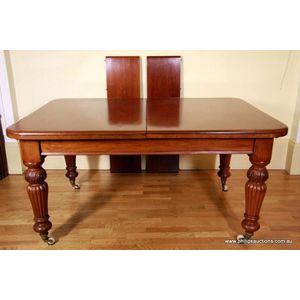Georgian Mahogany Extension Table with Paterae Decoration
You must be a subscriber, and be logged in to view price and dealer details.
Subscribe Now to view actual auction price for this item
When you subscribe, you have the option of setting the currency in which to display prices to $Au, $US, $NZ or Stg.
- Patera - A small decorative device, used as ornament in Neo-classical style furniture. Patera (or paterae) are usually round or oval, in the form of stylized rosettes. In the best pieces they are carved directly into the timber, otherwise they applied to the surface. Sometimes painted or inlaid motifs in the style are referred to as patera. Also known as a boss or a rosette.
- Fluting - A form of decoration found on many pieces of furniture, as well as ceramics, silver and clocks, in which round-bottomed grooves, of varying width and depth, are let into columns, pilasters, legs. As a general rule, flutes are cut in the vertical, though they may follow a turned leg in a spiral pattern. In cross-section, they may be described as a series of 'U' shapes, rising and narrowing at each end of the groove. Fluting is the opposite of reeding, with which fluting is often associated.
- Georgian - As an English stylistic period, Georgian is usually taken to cover the period from George I (1714) to the Regency of Prince George (1811-20), although the period from 1800 to 1830 is sometimes designated as the Regency period. During the Georgian period the great English cabinetmakers and designers such as Chippendale, Hepplewhite, Adam Sheraton etc., were all active.
Therefore there isn't a single 'Georgian style' as such and to say something is 'Georgian', usually means it was made between 1714 and 1830. This assumes we discount George V and George VI, both being from the 20th century.
The styles popular at the time of each reign were:
George I (1714-1727) saw out the last years of the Baroque period.
George II (1727-1760) reigned during the Rococo period.
George III (1760-1820) saw the last gasp of the Rococo, all of the early Neo-Classic 'Adam style' and most of the later neo-Classic 'Regency style'.
George IV (Prince Regent 1820-1830)encompassed the last of the 'Regency' style.
William IV's reign (1830-1837) was something of a no man's land (stylistically) and he wasn't a 'George' anyway. He covered the last glimmerings of 'Regency' and the start of the 'Victorian' style. - Mahogany - Mahogany is a dense, close grained red-coloured timber from the West Indies and Central America. It was first imported into Europe in the the early 18th century and its use continued through the 19th century. It was popular for furniture making because of its strength, the wide boards available, the distinctive grain on some boards, termed flame mahogany and the rich warm colour of the timber when it was polished.. The "flame" was produced where a limb grew out from the trunk of the tree, and this timber was usually sliced into veneers for feature panels on doors, backs and cornices.
Some terms used to describe mahogany relate to the country from which it originally came, such as "Cuban" mahogany, "Honduras" mahogany etc. However unless the wood has been tested the names assigned are more a selling feature, rather than a true indication of the timber's origin. - Reeding - A series of parallel, raised convex mouldings or bands, in section resembling a series of the letter 'm'. The opposite form of fluting, with which it is sometimes combined. Reeding is commonly found on chair legs, either turned or straight, on the arms and backs of chairs and couches and around table edges in the Neoclassical or Classical Revival manner. Reeding was also used as a form of decoration during the Edwardian period, but it is usually much shallower and evidently machine made.
This item has been included into following indexes:
Visually similar items

A Georgian mahogany extension dining table, early 19th century, with two extensions and associated brass locks, an elegant table in rich tones with a bullnose edged top with rounded corners and raised on reeded legs to toupie feet with brass casters, heigh

A Victorian cedar extension dining table. second half 19th century, with two extension leaves and winder, the square table with rounded ends above a deep skirt with a reeded trim and supported on four waisted baluster reeded legs with foliate carved caps,

A Victorian mahogany extension table, circa 1880, with two additional leaves, the top with moulded edging above a simple skirt and baluster shaped lobed legs, terminating in turned feet with casters. Height 72 cm. Width 125 cm. Depth 110 cm, total. Width w

A Victorian mahogany extending dining table, 1870s/'80s, the rectangular top (with two spare leaves) with a moulded edge above a plain frieze, raised on turned legs with brass caps and castors. Height 75 cm. Length 238 cm. (extended) width 125 cm
